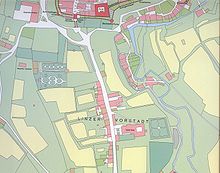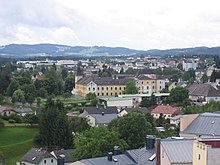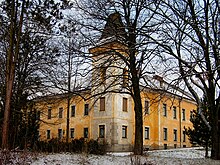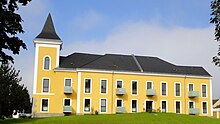House Zemannstraße 29 (Freistadt)
The listed building at Zemannstraße 29 in Freistadt , Upper Austria was built as a monastery at the beginning of the 17th century. Since the abolition of the monastery, it has been used as a palace, student residence, administration building, hospital and office building. The approximately 5500 square meter area belonged to Gespag . Since February 2013, the housing company Neue Heimat Oberösterreich has been converting the house into a residential building with age-appropriate apartments and a parent-child center.
history
- St. Mary's Monastery (1654–1785)

In 1626, the Capuchin Provincial Chapter decided to build a monastery in Freistadt. The city of Freistadt and above all Heinrich Wilhelm Graf von Starhemberg supported the construction. On October 1, 1639, the Passau bishop gave his approval and on September 8, 1643, the foundation stone of the monastery with the name of Saint Mary was laid . In 1654 the building was completed and on June 7, 1654 the church was consecrated by Passau Auxiliary Bishop Ulrich Grappler . Under Joseph II ( Josephinism ) the monastery was closed in 1785. Despite the citizens' request, the 13 fathers and 7 lay brothers had to leave the monastery, only 2 fathers remained in Freistadt as cooperators .
- Kinsky Castle (1786–1895)
Countess Rosa von Kinsky acquired the former monastery and chapel in 1786 and converted it into a baroque palace. At that time, Freistadt had three castles, the Salzhof , the Habsburg Castle and the Kinsky Castle. From 1798 until the abolition of the manorial rule (1848), the castle served as the manor seat of Freistadt-Haus and for the family goods. It remained in the family until 1895. After 1848 the management of the property was relocated to Rosenhof Castle near Sandl .
- Municipal student convict (1898–1938)
In 1895 the city of Freistadt acquired the castle for 20,000 guilders and converted it into a student convict (dormitory for students from the nearby state high school ) by 1898 , which existed until 1938. The writer Roderich Müller-Guttenbrunn (autumn 1902 to August 1904 and autumn 1906 to January 1908) also lived in the Konvikt the student convict is an essential location.
From 1915 the Russian officers of the Freistadt POW camp were housed in the park . The guards lived in a room in the Konvikt. On January 10, 1915, 104 pieces of furniture had to be handed over to the prison camp. Between 1926 and 1938 the Marianists from the Marianum in Freistadt ran the Konvikt. In 1926, the building's church was remodeled into a chapel.
- Nazi student home, NSDAP district administration (1938–1945)
After the Anschluss , a Nazi student hostel was built in this building and the NSDAP district administration also moved in .
- Soviet headquarters (1945–1947)
After the Second World War , the Soviet occupying forces confiscated the building and set up the headquarters of the commandant's office. Soon afterwards the headquarters of the commandant's office was relocated to the Hagleitner house on the main square.
- Hospital (1947–1992)
The vacant house was rededicated as a hospital in 1947, and from 1963 onwards, the premises were extensively converted and the facade was simplified. In 1964 the organ from the Freistadt organ builder Lorenz Franz Richter from the Johanneskirche was installed in the chapel. The hospital existed until the opening of the "New Hospital" in 1992. The house in Zemannstrasse is still referred to as the "Old Hospital" by the people of Freistadt .
- Branch of the State Psychiatric Clinic (1993–2002)
In 1993, part of the building was converted into a branch of the state mental hospital Wagner-Jauregg . The mental hospital existed until it was closed in 2002. No modifications were made during this time, as the branch was only viewed as an interim solution.
- Transition and planning period (2002-2013)
Since 2002 there have been regular discussions about the long-term use of the area, as a social center, as a workshop for the long-term unemployed, as a nursing home for the elderly, as an office building and much more. The building has not been completely empty since then, as a temporary solution various companies and organizations were quartered: Among them a psychosocial counseling center , the Mittelschüler-Kartell-Verband K. Ö. St. V. Nibelungia and a specialist in gynecology .
In the summer of 2008, the final determination of the continued use of the building was made. A four-star Hotel Salzbaron with 134 beds and a wellness area should be built by 2013 , which would have increased the city's current tourist bed capacity by around 50%. In addition to investors from the Czech Republic and Leonding , the municipality of Freistadt was also involved in the operator consortium. The castle character should be preserved during the renovation. Since half of the park also belongs to the housing association Neue Heimat and this is not being rededicated for residential buildings, Neue Heimat will be integrated into the project.
The hotel project was filed in 2010, instead the building with apartments and a social facility was to be used.
Future use
In February 2013, the housing cooperative Neue Heimat started with the renovation work to adapt the listed building as a senior citizens' home and parent-child center. The planning is carried out by the Arkade architects under the project name "Wohnoase". The first apartments are to be occupied from mid-2014.
The renovation and adaptation of the building was completed in summer 2014. Most of the apartments are now (August 2014) already occupied.
construction
The building is a two-storey building complex with hipped roofs and an extensive park. The buildings are grouped around an almost square inner courtyard. There is a three-story tower on the southeast side. The chapel is an independent three-axis building with arched double windows. The former church was dedicated to the birth of the Most Holy Virgin Mary . In 1926 the storeys were divided, creating today's single-bay chapel.
Meierhof
The associated meierhof of the monastery is also two-story and today bears the house number Zemannstrasse 25 . The building is a construction from the 17th or 18th century and has curved gables. Inside there are flat barrel and cap vaults.
literature
- Georg Dehio (greeting), Peter Adam (editing): Upper Austria Mühlviertel ( art monuments of Austria ). New edition Berger Verlag, Horn / Vienna 2003, ISBN 978-3-85028-362-5 .
Web links
- Othmar Rappersberger: History of Freistadt - detailed. From the golden book of the city of Freistadt. Retrieved September 8, 2019.
Individual evidence
- ^ Diocese of Linz: History of the Diocese of Linz. Page 108f., Online (PDF) in the forum OoeGeschichte.at.
- ↑ Dr. Othmar Rappersberger in the 113th annual report of the Federal High School Freistadt, self-published, 1983.
- ↑ Freistadt's connection life in literature. The forgotten city / the students of Hohenstadt. Excerpt from the book The Forgotten City , accessed on September 8, 2019.
- ^ Fritz Fellner: The city in the city. The prisoner of war camp in Freistadt 1914-1918. In: Upper Austrian homeland sheets . Issue 1, 1989, page 12, online (PDF) in the forum OoeGeschichte.at.
- ↑ Municipality of Freistadt: Current from the town hall, 02/2004 (PDF; 1.09 MB).
- ↑ Municipality of Freistadt: Setting the course for the hotel project Salzbaron. Retrieved May 25, 2008.
- ^ ORF Online: New Hotel in Freistadt , accessed on March 1, 2009.
- ^ OÖ Nachrichten: Aus for the hotel in the old Freistadt hospital, social facility planned. Retrieved September 9, 2010.
- ^ Municipality of Freistadt: The house in the country. Retrieved April 23, 2013.
Coordinates: 48 ° 30 ′ 27 ″ N , 14 ° 30 ′ 18 ″ E



